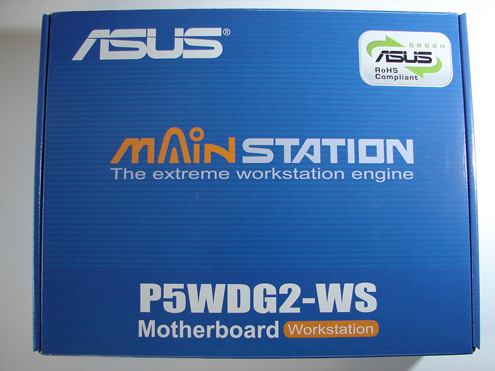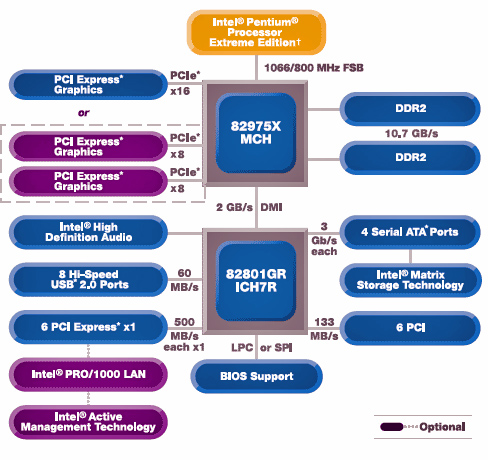Asus P5WDG2-WS: Intel 975X goes to Work
by Gary Key on December 6, 2005 12:05 AM EST- Posted in
- Motherboards
"An idea, to be suggestive, must come to the individual with the force of revelation."
This quote from the American philosopher and pragmatist William James led us to try a few different testing methodologies for today's article. We are reviewing the Asus P5WDG2-WS motherboard along with comparison scores to the Gigabyte GA-G1 975X. While the two boards are targeted for completely different audiences, both utilize Intel's excellent 975X chipset. Asus will be releasing the P5WD2-E for the enthusiast market in the near future and we will directly compare it to the Gigabyte GA-G1 975X at that time.

The Intel MPT has been enhanced to offer improved pipelining to enable a higher utilization of each memory channel, resulting in better performance through increased transfers between the processor and system memory. Intel Flex Memory Technology allows different memory sizes to be populated and still remain in dual-channel mode.
The new architecture also supports both asynchronous and isochronous data traffic, with dedicated internal pipelines and specialized arbitration. In addition, the 975X chipset has improved electricals with optimized ball-out for better latency.
The 975X chipset offers full support for graphic based PCI Express x16 lanes that can be configured as two PCI Express x8 slots for multi-view or GPU capability. The 975X chipset fully supports ATI CrossFire technology. Further technical details of the 975X chipset can be download in PDF format at Intel's website.
Asus chose to augment this feature set with additional SATA II capabilities via the Marvell 88SE6141 chipset, PCI-X capabilities via the Intel 6702PXH chipset, and Firewire 1394a support via the TI TSB43AB22 chipset.
Let's see how this board compares to others.










31 Comments
View All Comments
Gary Key - Tuesday, December 6, 2005 - link
We are still working on a way to properly show this in the graph engine.Thank you.
imaheadcase - Tuesday, December 6, 2005 - link
I saw this article 2 times put up already. anyone else seeing this?Last half a dozen reviews show up, i see people comment on them, then they disappear and come back latter. weird
wilburpan - Monday, December 5, 2005 - link
According to your Ethernet tests:Gigabyte GA-G1975X: 951.4 Mb/s
Asus P5WDG2-WS: 950.3 MB/s
Gigabyte GA-G1975X: 16.04% cpu utilization
Asus P5WDG2-WS: 23.78%
And in your text:
"The Marvell 88E8062 PCI Express Dual LAN solution exhibits slightly higher throughput along with very good CPU utilization rates. The Broadcom 5789KFB option on the Gigabyte board offers excellent throughput, but at a slightly higher CPU utilization than on other solutions."
With the data you have, it seems the exact opposite conclusion should be made.
Gary Key - Tuesday, December 6, 2005 - link
Hi,Unfortunately, our document engine had a mind of its own last night when the article went up the first time as it was not completed yet. The last couple of pages are correct now along with additional information that was not available last night. We had to wait on Asus to provide shipping drivers and Marvell firmware which changed the original scores (went down but stability increased). The new graphs were correct but my text changes had not caught up yet. We have been informed by Asus the 88E8066 chipset will actually be used on the board in the near future.
Thank you.
BrownTown - Tuesday, December 6, 2005 - link
interesting stuff for the Presler there, I eagerly await your new article :pDanDaMan315 - Monday, December 5, 2005 - link
yayVegito - Tuesday, December 6, 2005 - link
Juicy.. I just need these pcix + pcie board for an amd machine.. :)Gary Key - Tuesday, December 6, 2005 - link
We highly suggested this to Asus. ;->Pirks - Tuesday, December 6, 2005 - link
Many many years from now we'll get another Asus or any other r333w1 mobo (DFI LanParty Ultra 3.0? :) with quantum 1000 GHz CPU, UltraWideFirewire 24000, USB 8.0, built in laser keyboard link and wireless 80" display link... and a LOT more... and.......AND...
...and A FLOPPY CONNECTOR!!!
and AN LPT PORT!!!!!
and PS/2 JACKS!!!!!!
AND TWO, LISTEN TO THIS - !TWO! COM PORTS!!!!
bwahahahahahahaaaaa
I just can't look at all the museum artefacts on these so called "professional" mobos, when Macs have only USB and FW as their standard interfaces for years!
Yea I know Mac hardware is sucky/expensive, no cool gaming and stuff, but... I really understand well some of my Mac using buddies when they visit me while I'm working on one of my PC's "professional" mobos (upgrading heatsink or something), and they see one of these huge LPT connectors and they're like "WTF???!?!?"
I know noone cares about this stuff, noone will ever make decent and inexpensive legacy free PC mobo, just wanted to vent it off... thanks :)
Saist - Tuesday, December 6, 2005 - link
obviously you have never tried to run a data center, or ever bought hardware on a budget, nor that you run windows...or are you conviently forgetting that Windows has the worst in-box hardware support available and that to run many SATA drives requires installing drivers as though they are SCISI devices rather than on-chip devices.
Or that not everybody can afford to upgrade to a new laser jet / ink jet / Hp OfficeJet at every new release, and that for many a business the stock dot matrix offers the best price/performance and there is no reason to replace a perfectly functioning dot/matrix printer for something that costs a lot more to run.
or that usb support for keyboards is a little spotty in the Microsoft bootloader if you do try to run multiple versions of windows
Or that many older devices still require the com ports.
Sure, if you are building a brand new computer and have no hardware you ever intend to run again, running a legacy free system is a good idea.
But, when you only have 5% of the market at best...
it just doesn't make sense.
Sorry, but I find the laughter and your comments to be so far off base... I can only sigh and wish I had your budget to spend.